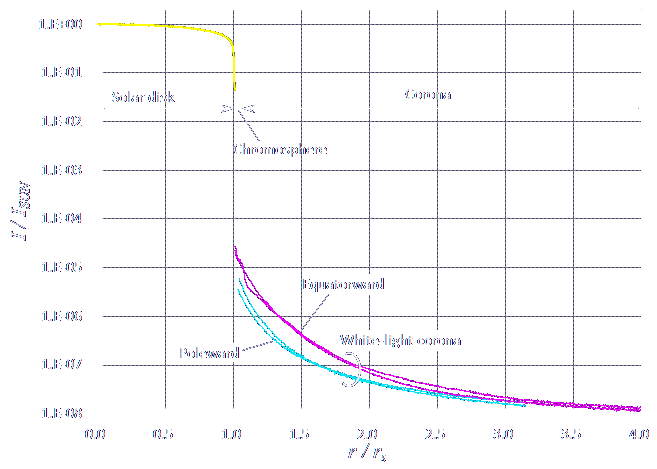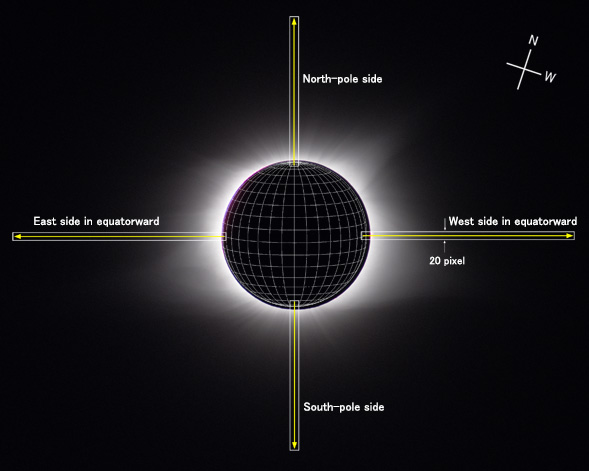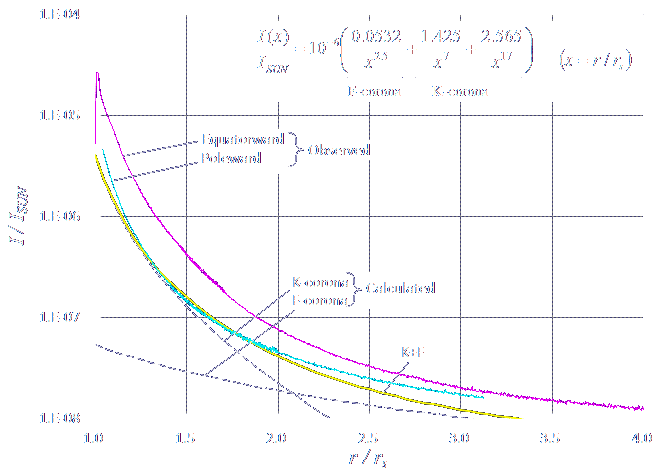Brightness distribution of the white-light corona on Aug 21, 2017

Radial distribution of relative brightness of white-light corona
(ISUN... Brightness of central solar disk, rS... Apparent radius of the sun)
Yellow... Solar disk, Magenta... Corona in equatorward, Cyan... Corona in poleward |

Measured regions of colonal brightness
Acquired average counts in 20-pixels-width in four directions with Makali'i 2.1 |
Photography condition of images used for measurement:
|
| Date & Time: | Aug 21 2017, 10:17:27 & 10:19:05 (Corona), 11:38:03 (Solar disk) PDT(+0700) |
| Corona... 1/1000sec.×2shots (r/rS<1.5), 1/125sec.×2shots(r/rS>1.5), Solar disk... 1/4000sec.
with BaaderPlanetarium AstroSolar filter (Used for solar disk) |
| Optical: | BORG 60ED with a correction lens (f=378mm, F6.3) |
| Auto-guided with EYEBELL CD-1 portable Equatorial |
| Digital Camera: | Nikon D810A |
| Location: | Salem, Oregon, USA |
| Camera Settings: | Recording Format...14bit CCD-RAW, converted to 32bit FITS (7360×4912),
corrected with dark & flat flames |
| Device Size...FX format (36×24mm) |
| Sensitivity...ISO800 (Corona), ISO400 (Solar disk) |
This page indicates the radial distribution of solar coronal brightness using of solar eclipse images on Aug 21, 2017.
As shown in right image, I have acquired the numeric counts of averaged white-light coronal brightness in 20-pixels-width along four directions.
A left figure shows the acquired brightness in logarithmic scale relative to that at the central solar disk, ISUN,
as a function of radial distance from solar center normalized with the apparent solar radius, r/rs.
The innermost corona has brightness of approximately a hundred-thousandth of that of the solar disk, almost equivalent to the full moon's brightness.
The coronal brightness decreases drastically with increase of r/rs, down to approximately 1/1000 of that of innermost at around r/rs=4.
Moreover, you can recognize that the brightness in poleward corona has about a half to one third of that in equatorward.
 Comparison of brightness distribution of white-light corona with theoretical equation
Comparison of brightness distribution of white-light corona with theoretical equation
Magenta... Observed coronal brightness in equatorward (Average of east & west directions)
Cyan... Observed coronal brightness in poleward (Average of north & south directions)
Yellow... Calculated brightness of white light corona with theoretical equation[1]
An upper figure shows a comparison of the radial distribution of the white-light coronal brightness with a theoretical equation[1] indicated in the figure.
The hydrogen atoms in the inner corona have been almost perfectly ionized.
Its brightness is dominated with the Thomson-scattering of solar light by the free electrons; the corona with the brightness component is called "K-corona".
The brightness of K-corona attenuates drastically being in inverse proportion to approximately seventh-power of r/rs.
On the other hand, the coronal white-light brightness has another component of "F-corona" due to the scattering with dusts in the solar system.
The brightness of F-corona is predominant farther than r/rs=2, can be observed beyond the outer corona and connects to the Zodiacal light.
Although the calculated distribution of coronal brightness can almost represent the observed one in poleward, not completely match due to the influence of local fluctuation of brightness.
More, this observation could not secure the sufficient accuracy in brightness of solar disk; the observed value of coronal brightness includes comparatively larger error.
Reference:
[1] J. Fukue, et al., "Total Eclipse 2012 at Cairns in Australia; Total-Annular Eclipse Project of Osaka Kyoiku University",
The Astronomical Herald (The Astronomical Soc. of Japan), vol.106, no.5Cpp.334-341, 2013 (in Japanese).


